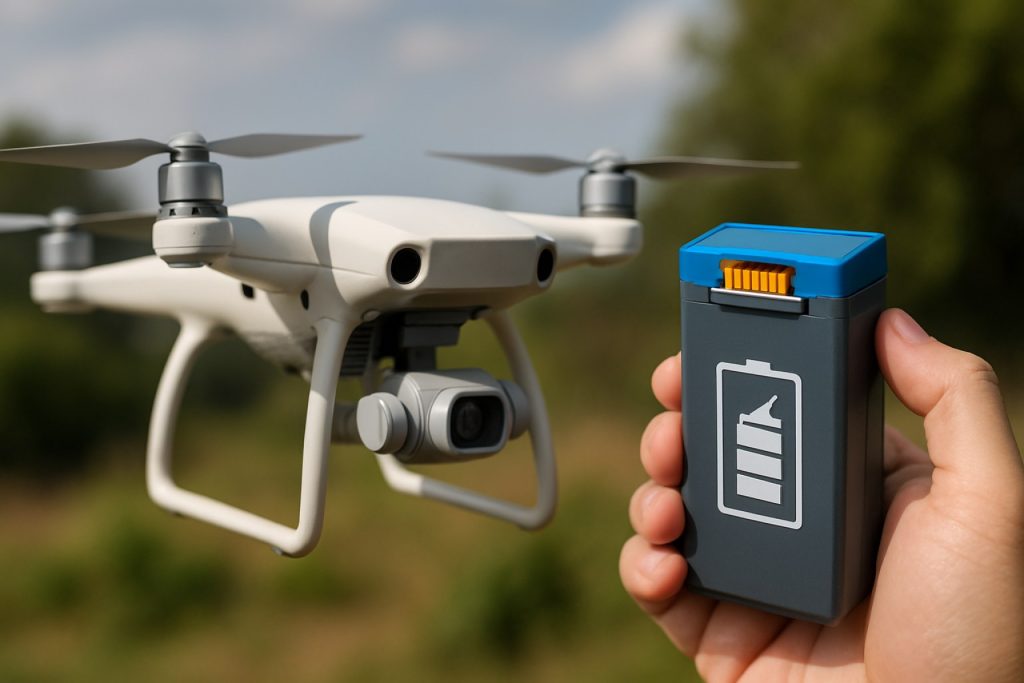
- Solid-state batteries, like Factorial’s FEST platform, are revolutionizing drone technology by offering up to 50% higher energy density compared to traditional lithium-ion packs.
- These advanced batteries enable drones to fly longer distances, carry heavier payloads, and operate in extreme environments, significantly enhancing mission range and safety.
- Avidrone Aerospace is integrating FEST lithium-metal cells, aiming to double operational range without increasing size or cost.
- Solid-state battery technology improves reliability and reduces fire hazards, making it ideal for defense, logistics, and disaster response applications.
- The drone market is rapidly expanding, with projections exceeding $36 billion in four years, and solid-state innovation is expected to define future industry success.
Propellers thrumming against the sky, drones race across hostile mountains, remote forests, and urban jungles—pushing boundaries not by aerodynamics alone, but now by the relentless march of battery innovation. A seismic shift is unfurling in the world of unmanned aerial vehicles: cargo drones are about to be powered by the same next-generation batteries driving the electric vehicle revolution.
At the heart of this leap lies the FEST (Factorial Electrolyte System Technology), a solid-state battery platform developed by the U.S.-based company, Factorial. Shipping its lithium-metal cells directly to Canadian aviation pioneer Avidrone Aerospace, Factorial charts a new course: solid-state batteries, once reserved for electric cars, now poised to cut the tethers of performance limits for drones.
Solid-State Cells: The Energy Behind the Mission
Unlike typical lithium-ion packs, solid-state batteries use a solid electrolyte in place of volatile liquids. This innovation doesn’t merely eliminate a fire hazard—it packs up to 50% additional energy into the same space. In the world of drones, energy density is destiny: every gram saved and every watt unlocked means longer missions, heavier payloads, and the ability to operate in environments where failure isn’t an option.
Avidrone’s flight engineers see the promise on their screens: simulation models predict the new FEST cells could double drone range with existing payloads. Imagine an emergency medical drone traveling twice as far with life-saving supplies, or a reconnaissance UAV tripling time above a crisis zone—all without increasing size or cost.
Pushing Boundaries in Extreme Conditions
But endurance isn’t the only frontier. The FEST platform is being tested under punishing real-world conditions: Arctic chill, desert heat, and the relentless vibration that comes with high-speed flight. Solid-state cells don’t just pack more power—they also provide a margin of safety and reliability that’s crucial in critical missions for defense, logistics, and disaster response.
As global defense budgets swell and demand for unmanned systems climbs—market analysts see the drone sector ballooning by over $36 billion in the next four years—technology like Factorial’s is primed to define the edge between success and irrelevance. Military applications alone could spike to $65 billion by 2032, fueled by a voracious need for drones that can stay aloft, carry more, and deliver intelligence in real time.
A Launchpad for the Future
This partnership between Avidrone and Factorial marks more than a technology transfer—it’s a battle test for the future of energy storage. By forging early adoption in high-stakes aerospace contexts, Factorial aims to refine its batteries for both aerospace and terrestrial markets, all while keeping the design, manufacturing, and integration of these critical technologies rooted in North America.
As governments and companies clamor for domestically developed, reliable energy sources that can power the essential tools of commerce, safety, and security, Factorial’s foray into aviation is a signal flare. The real-world performance of FEST-powered drones will dictate a new class of missions, opening doors for everything from transcontinental cargo flights to first-responder networks that leap beyond today’s range limits.
The Takeaway: Solid-state batteries, proven in the pressure cooker of aerospace operations, are poised to upend how drones—and eventually all electric vehicles—are powered. The sky, quite literally, is no longer the limit.
Curious about breakthroughs in energy? See how others are transforming the way we move at Tesla and explore the evolving world of technology at Google.
Drone Revolution: How Solid-State Batteries Could Transform Aerial Deliveries, Emergency Response, and the $65B UAV Industry
The Solid-State Battery Breakthrough: What Makes This a UAV Game-Changer?
The recent integration of Factorial’s FEST (Factorial Electrolyte System Technology) solid-state batteries into Avidrone Aerospace’s cargo drones marks a pivotal leap in unmanned aerial vehicle (UAV) technology. Here’s what’s truly driving the excitement—and what the source article didn’t dive deeply into:
What Sets Solid-State Batteries Apart?
1. Superior Energy Density
Solid-state batteries can store up to 50% more energy in the same volume than traditional lithium-ion. This translates to longer flights, heavier payloads, and extended range.
2. Improved Safety Profile
The solid electrolyte is non-flammable, dramatically reducing fire risks—a critical consideration for drones used in search and rescue or urban delivery.
3. Wider Operating Temperature
These new batteries withstand extreme cold and heat much better than standard cells, vital for drones operating in polar, desert, or wildfire zones.
FEST Technology: Specs & Performance
– Energy Density: Up to 400 Wh/kg (compared to 270 Wh/kg for best lithium-ion packs).
– Cycle Life: Early lab results show over 1,000 charge cycles with <15% degradation (source: [Factorial](https://www.factorialenergy.com)).
– Safety Layer: Built-in ceramic separators stop short circuits that cause thermal runaway.
– Form Factor: Customizable to UAV chassis—enabling thin, modular packs.
Real-World Use Cases: Where Will We See the Biggest Impact?
– Medical Supply Drones: Deliver blood, vaccines, or AEDs across twice the distance without recharging.
– Firefighting/Disaster Response: Longer autonomous flight means more time surveying hazards or air-dropping supplies.
– Inspections & Surveying: Infrastructure checks (power lines, pipelines) with fewer landings, reducing risk and cost.
– E-commerce & Urban Logistics: Faster, farther, and more reliable parcel deliveries.
—
How-To Steps: Upgrading a Drone Fleet to Solid-State
1. Assess Compatibility: Review UAV specs; hybrid and custom-built drones adapt most easily.
2. Partner with Battery Manufacturer: For specialized integration, work closely with providers like Factorial or QuantumScape.
3. Simulation & Testing: Run flight simulations for thermal, vibration, and cycle life profiles.
4. Pilot Trials: Conduct real-world missions in varied climates to validate performance.
5. Scale Deployment: Gradually replace lithium-ion stock with solid-state across mission-critical fleets.
—
Industry Trends & Market Forecasts
– Solid-State Battery Market: Expected to grow at over 34% CAGR, reaching $8B in automotive/aerospace by 2030 ([BloombergNEF](https://about.bnef.com)).
– UAV Market: Projected to hit $65B in military and $36B in commercial sectors by 2032, with energy storage as a top innovation.
– Major Partnerships: Ford, Mercedes-Benz, and Hyundai have announced EV programs around solid-state chemistry—expect spillover to aerospace.
—
Reviews & Comparisons
Solid-State vs. Lithium-Ion in UAVs:
| Feature | Solid-State | Lithium-Ion |
|——————–|——————|———————|
| Energy Density | Higher (up to 50%)| Moderate |
| Safety | Superior (no fire risk) | Risk of fire/thermal run. |
| Life Cycle | 2-3x Longer | Shorter |
| Cost (as of 2024) | 2-4x Li-ion | Mature/cheaper |
| Fast Charging | Equal/Better | Good |
—
Limitations & Controversies
– Cost: As of 2024, solid-state batteries are expensive to produce, but costs are falling rapidly with scale.
– Manufacturing Challenges: Ensuring uniformity and defect-free solid electrolytes is complex.
– Supply Chain: Most solid-state tech is still in pre-commercial phases; broad supply remains limited.
Expert Insight
“Solid-state batteries have the potential to redefine electric aviation, but large-scale manufacturing and raw material sourcing still need major advances before mass adoption,” says Dr. Linda Thomas, Battery Research Lead at MIT.
—
Security & Sustainability
– Security: Reduced flammability increases operational safety, especially over populated areas.
– Sustainability: Higher efficiency and lifespan reduce battery waste; next-gen designs aim to use fewer rare metals.
—
Top Questions Readers Ask
1. When will solid-state drones be widely available?
Initial commercial deployments expected in niche/professional use (2024-2026), with mass-market scaling late in this decade.
2. Are there compatibility issues with current drones?
Most off-the-shelf drones will require custom integration or new designs due to different voltage and form factors.
3. Is this tech limited to drones?
No—EVs, robots, and even grid storage applications are rapidly evolving to include solid-state cells.
—
Quick Life Hacks & Tips
– For Drone Operators: Monitor indie aerospace news for announcements from Factorial, Avidrone, and similar pioneers.
– For Investors: Watch for patents, pilot programs, and OEM deals—these are signals of approaching commercialization.
– For Engineers: Focus on battery management systems (BMS) that can adapt to solid-state chemistry for a career edge.
—
Actionable Recommendations
– UAV fleet owners: Start R&D partnerships with battery tech pioneers to “future-proof” your operations.
– Municipalities & disaster agencies: Push for pilot programs leveraging solid-state drones for critical missions.
– Tech followers: Bookmark [Tesla](https://www.tesla.com) and [Google](https://www.google.com) for broad industry insights and technological innovation tracking.
—
Summary
Solid-state battery innovation, like Factorial’s FEST, unlocks dramatic gains in drone range, safety, and reliability—ushering in a new era for aerial logistics, emergency response, and the $65B UAV market. Integration challenges remain, but the trajectory is clear: the future of drone flight will be built on the backbone of next-generation energy storage.
Stay ahead of the curve by tracking tech advances, forming the right partnerships, and preparing to adopt these batteries for your most critical missions. The sky’s no longer the limit—it’s the launchpad.
For more on cutting-edge mobility and energy, see [Tesla](https://www.tesla.com) or explore big tech trends at [Google](https://www.google.com).



